Although not all, most betta fish tanks are bare naked. Only tank, water, and fish. Mostly we see this kind of setup in pet shops and adopted in some home aquariums.
But should it be the case? Could it be the reason why betta fish are motionless and bored? Can we add plants to improve the condition? Are plants and betta fish compatible?
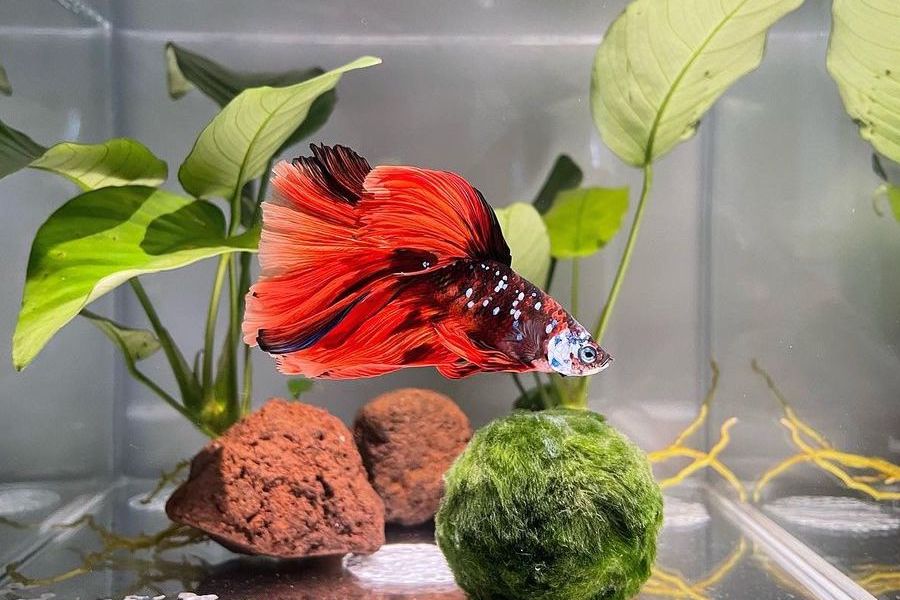
Join us as we explore the compatibility of plants and betta fish.
Wild Coexistence of Plants and Betta Fish
Betta fish originated from the neighboring countries of Thailand, Myanmar, Laos, Cambodia, and Vietnam. Rice paddies and other shallow low-running freshwater bodies (like ponds, marshes, and streams) abound in these Asian nations that have become the natural habitat of betta fish.
Plants are abundant in these freshwater ecosystems. They grow in large clusters, with their branches and root systems providing a conducive environment for betta fish to thrive and reproduce.
An example is the vegetable fern (Diplazium esculentum). Wild betta fish love to take refuge under this plant. It has even become an indicator for wild gatherers. Whenever there is a vegetable fern, betta fish is most likely to be found underneath it.
Benefits of Plants to A Betta Fish Tank
We have seen plastic decorative plants placed in a tank. Some people believe it adds beauty and improves aesthetics. Well, if you’re considering these reasons, we highly suggest using live aquatic plants.
Aside from being the real thing, live aquatic plants are generally cheaper than fake plastic decorations. Setting aside the price difference, plants do biological and chemical processes.
Although confined in a tank setup, plants provide the same benefits it offers in their natural environment.
Oxygen Production
Through the process of photosynthesis, plants produce oxygen. This photosynthetic production of oxygen is essential as it stabilizes dissolved oxygen and prevents your betta fish from spending energy swimming to the surface to breathe air.
Betta fish have the labyrinth organ that allows them to breathe from the atmosphere. When dissolved oxygen level is low, betta fish repeatedly swim to the surface and gulp in air.
Oxygen-producing plants eliminate the struggle of surface breathing, thereby restoring energy.
Removal of Unwanted Chemicals
Aside from consuming carbon during photosynthesis, plants absorb unwanted chemicals like nitrite, nitrates, and ammonia.
In general, plants make a betta fish tank chemically clean. In effect, they reduce the unwanted growth of algae since this kind of flora requires the mentioned chemicals to grow.
Provision of Hiding Places
Even in solitary confinement, betta fish do need shelter. Plants create a sanctuary for your betta fish to relax and enjoy.
Aesthetically, plants radiate a natural feel that pleases both you and your betta fish.
Best Plants for Betta Fish
The live aquatic plants we will mention here do not necessarily mean they come from the native home of betta fish in Thailand and neighboring countries.
While these plants are coming from different continents of the world, they are, however, commercially available in most pet shops and have been used by betta fish keepers.
Each of these plants has unique characteristics favorable to the survival and growth of betta fish.
Amazon Sword
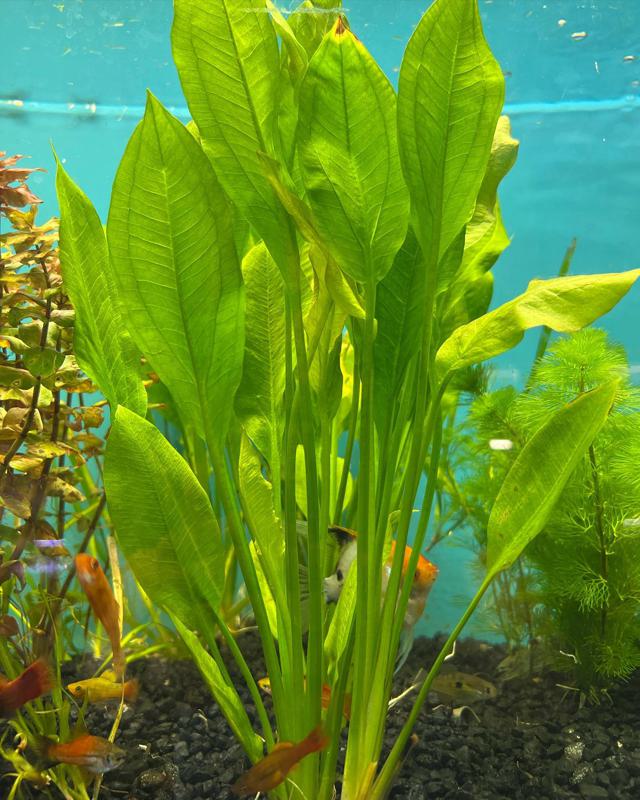
- Scientific name: Echinodorus sp.
- Origin: The Americas
- Difficulty of care: Easy to moderate
- Level of light: High
The main reason the Amazon sword is perfect for betta fish is its broad leaves. It creates a platform at various layers where betta fish can take refuge.
Consider having a thick substrate with this plant. Since the leaves sway, the plant can easily uproot. It needs to be rooted down a few inches in the substrate.
The plant can grow big (up to 3 feet tall), and using a small tank is not recommended. Amazon sword thrives best in a 10-gallon tank, at least.
Anubias
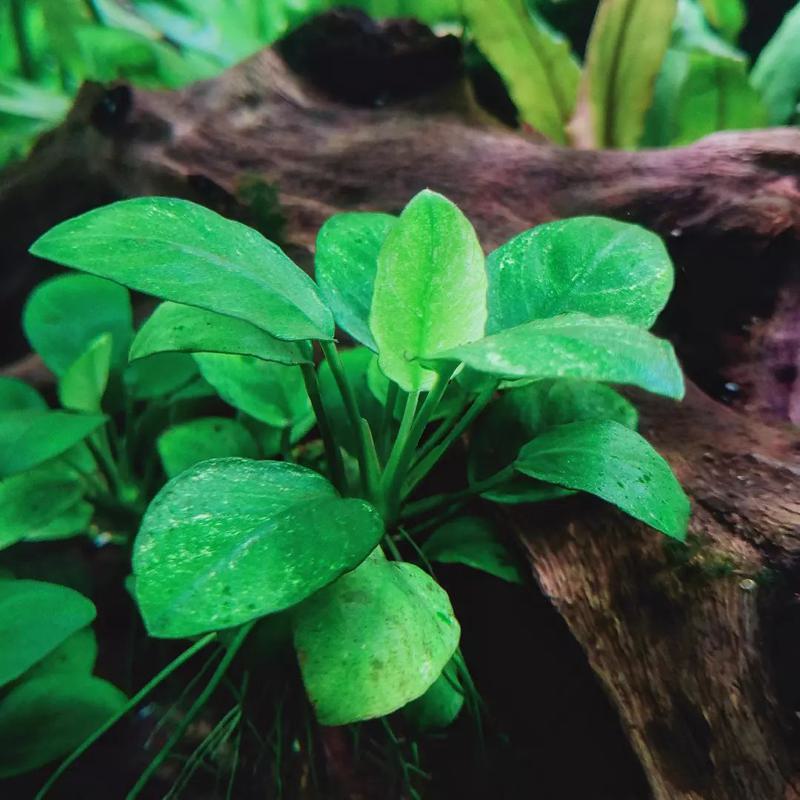
- Scientific name: Anubias barteri var. nana
- Origin: Cameroon, Africa
- Difficulty of care: Easy
- Level of light: Low
Despite having broad leaves, Anubias are slow-growing and small that can reach a maximum height of 10 cm.
They are ideal for small betta aquariums and can even fit in a 2-gallon tank. Once settled, betta fish will often rest under its leaves.
Anubias have many good traits making them compatible with a betta fish tank.
Aside from the ease of care, Anubias don’t need artificial light. A good source of natural light will do. If you’re not using any substrate, Anubias can be attached to rocks or driftwood, making them aesthetically versatile.
And finally, don’t worry about nibbling. Especially for snails, their leaves are not as palatable as other aquatic plants.
Java Fern
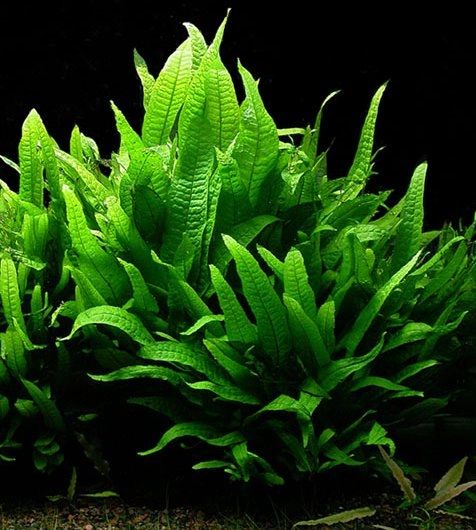
- Scientific name: Microsorum pteropus / Leptochilus Pteropus
- Origin: Southeast Asia
- Difficulty of care: Easy
- Level of light: Low
The Java fern is one of the plants that naturally exist in the betta fish ponds in Thailand.
The long, thick, and vertical-growing leaves act as natural hallways for betta fish. Despite being a slow grower, Java ferns are easy to care for and do not require bright lightning.
For newbies, rooting them in the substrate will often lead to the plant dying. You may bury the rhizome – a horizontal stem where leaves grow out on top and roots underneath it.
Be aware that Java ferns do not need a substrate to grow. Attaching them to driftwood or rock with a rubber band or glue will do.
We do not advise having multiple Java ferns at the start. Despite slow-growing, Java ferns will produce baby ferns along the matured leaves. You can cut the baby ferns and place them on another part of the tank.
Water Sprite
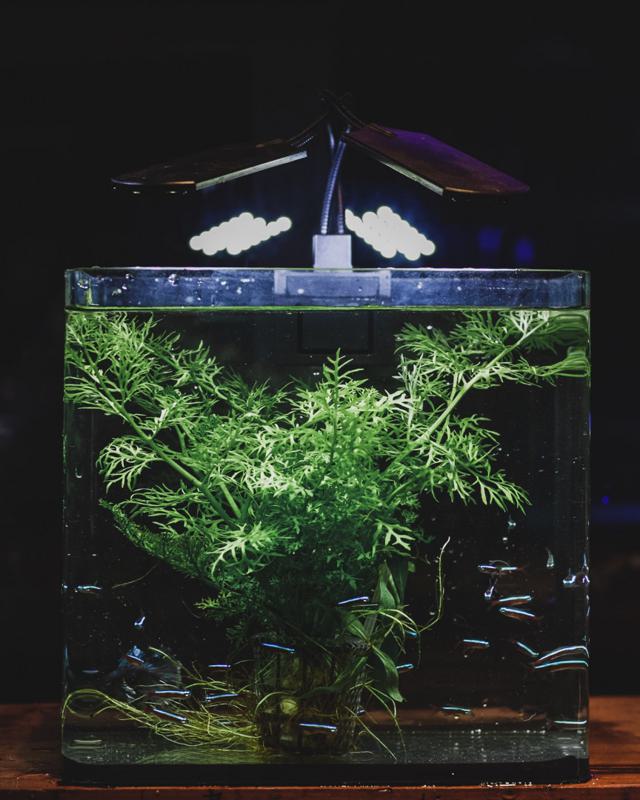
- Scientific name: Ceratopteris thalictroides
- Origin: Tropical regions
- Difficulty of care: Easy
- Level of light: Moderate
Consider the water sprite if you want to create a playground for your betta fish. These lacy-leaf plants are a fast grower and easily create a dense jungle ambiance for your betta fish.
With their ease of care, they are recommended for newbies. While they can tolerate low light, they prefer moderate lighting. Growing fast means they consume a lot of nutrients, especially those that are not wanted by your fish.
You have the option to root them down the substrate or just free-floating. Just be aware that with their fast-growing capabilities, they can become a nuisance to other plants as they take up space and hinder others from growing underneath them.
With this, trimming is encouraged. You can do this by cutting the base of the stem. Discard the cut-off leaves since they will rot in the tank.
Further, their dense leafing encourages betta fish to build their bubble best. So, be mindful and inspect the plant before cutting.
Java Moss

- Scientific name: Taxiphyllum barbieri / Vesicularia dubyana
- Origin: Southeast Asia
- Difficulty of care: Easy
- Level of light: Low
The Java moss is different from the Java fern. While originating from the same region in Southeast Asia, they are different anatomically.
Java ferns have long, thick leaves, while Java moss has short stems with tiny leaves. Following an irregular growth pattern, stems could grow from 3 to 10 inches long.
You can differentiate the old from the new stem. Old stems are colored dark green, while new stems are bright green.
For betta fish to enjoy the Java moss, allow them to encrust and carpet along driftwood. They don’t have roots, and they grow along any structure.
Related: Best Carpet Plants for Aquariums
Christmas Moss
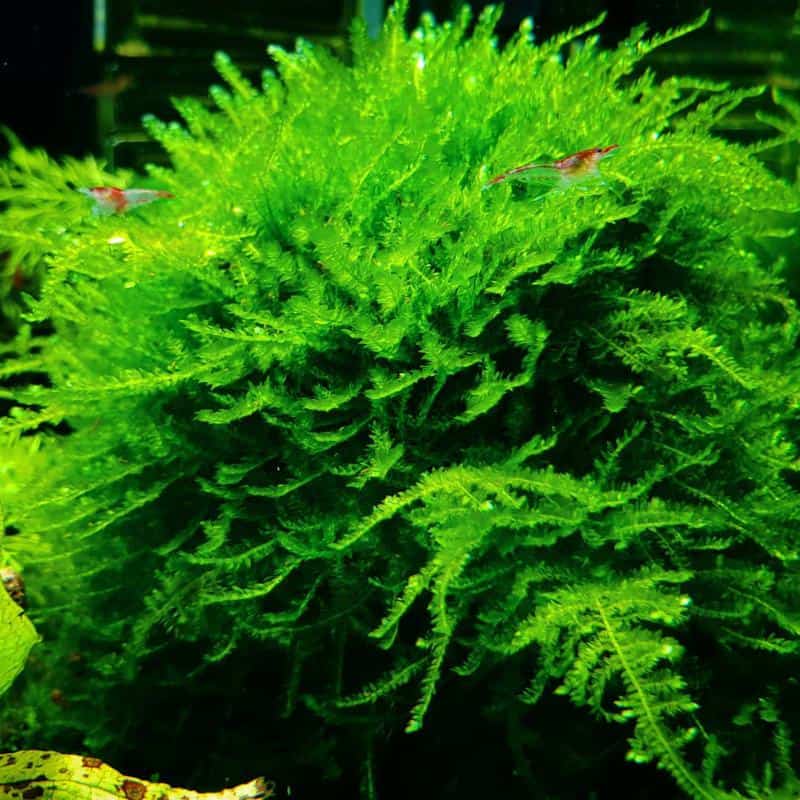
- Scientific name: Vesicularia montagnei
- Origin: Brazil
- Difficulty of care: Easy
- Level of light: Moderate
Unlike the irregular growth of Java moss, Christmas moss has a tidy appearance.
At the start, do not expect that the plant will look like a Christmas tree. But you can do so if you use driftwood as basal mold. When the roots are attached, it starts to grow, and their overall appearance resembles a fir tree.
Once these plants mature, betta fish will start coming in and taking refuge under the canopy Christmas moss has provided.
Cryptocoryne / Water Trumpet
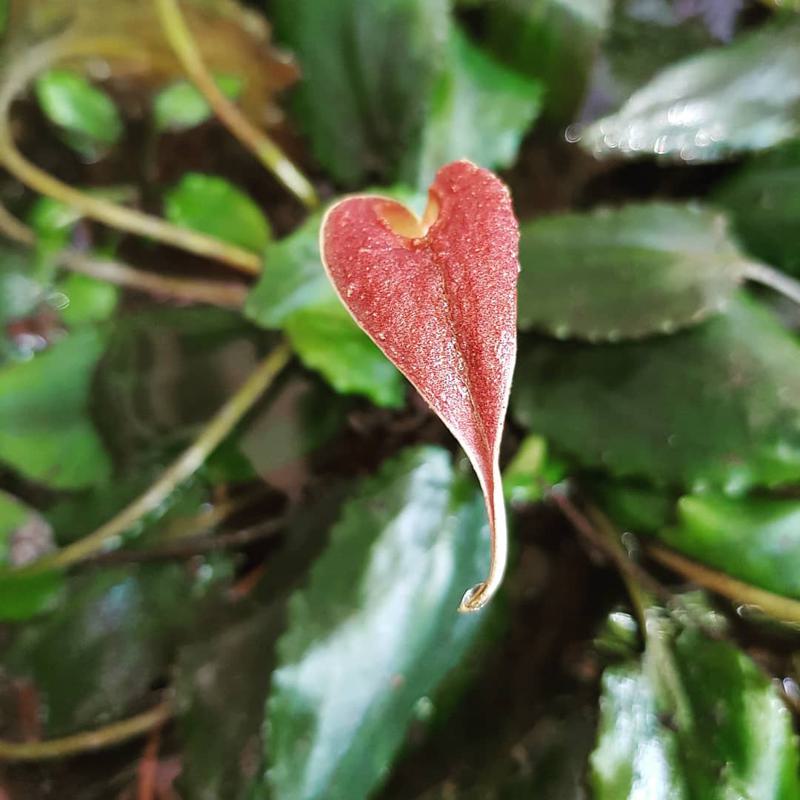
- Origin: Highlands of Sri Lanka
- Difficulty of care: Moderate
- Level of light: High
When this plant flowers, it protrudes a thick and fleshy spike that looks like a trumpet, thus its name.
But what betta fish loves about the water trumpet is not the flower. They prefer resting on top or under its broad and slender leaves.
While they are versatile to lightning, they should be rooted in the substrate. Being a foreground plant, they start to carpet the substrate as they grow.
Water trumpets have a unique way of absorbing nutrients. Instead of directly getting nutrients from the water, these plants extract nutrition from the ground.
Note: Water trumpets are known to sag and fade after planting in a condition termed crypt melt. When you see this condition, you don’t need to do anything. Leave it as is. Your plant is undergoing an adaptive phase and will recover with the growth of new leaves.
Anacharis
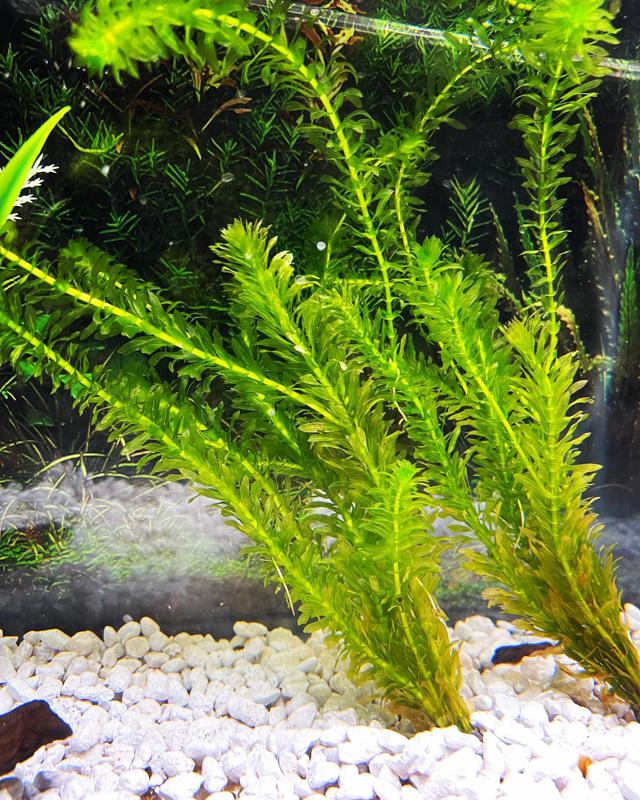
- Scientific name: Elodea densa
- Origin: South America
- Difficulty of care: Easy
- Level of light: Moderate
Also called Brazilian waterweed, Anacharis is a fast-growing plant that can grow up to 4 meters in length in their wild habitats of South America.
Betta fish love Anacharis since they provide shelter and absorb unwanted toxins in the water. Hobbyists also love these plants as they are great for aquascaping.
Whether you root them in the substrate or not, the end result is that this plant will grow until it reaches the surface. As it grows, the leaves create a spiral pattern ending with a pointy tip.
Caution: Anacharis is an invasive species. They infest and dominate local plant species if released in the wild. So, be mindful if you trim them. Properly discard any unwanted plant parts.
Banana Plant
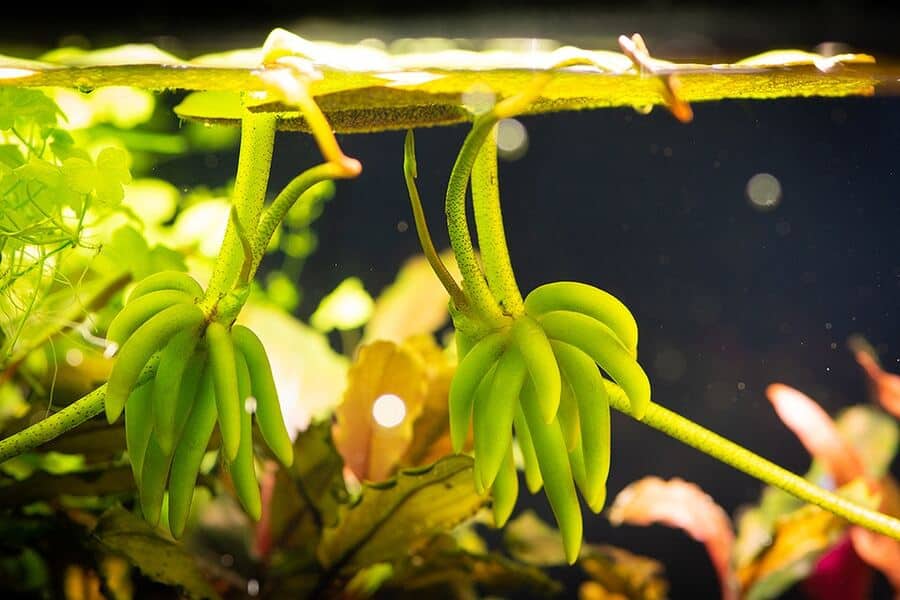
- Scientific name: Nymphoides aquatica
- Origin: United States
- Difficulty of care: Easy
- Level of light: Moderate
A banana plant is not a banana plant in the truest sense. The bananas you see in this plant are not fruits. They are specialized roots that store a large number of nutrients.
Betta fish loves the broad leaves of these plants as they vertically grow toward the surface with floating lily pads.
When they branch out, they cover the surface and may impede the penetration of light, hindering other plants growing underneath them.
Vallisneria
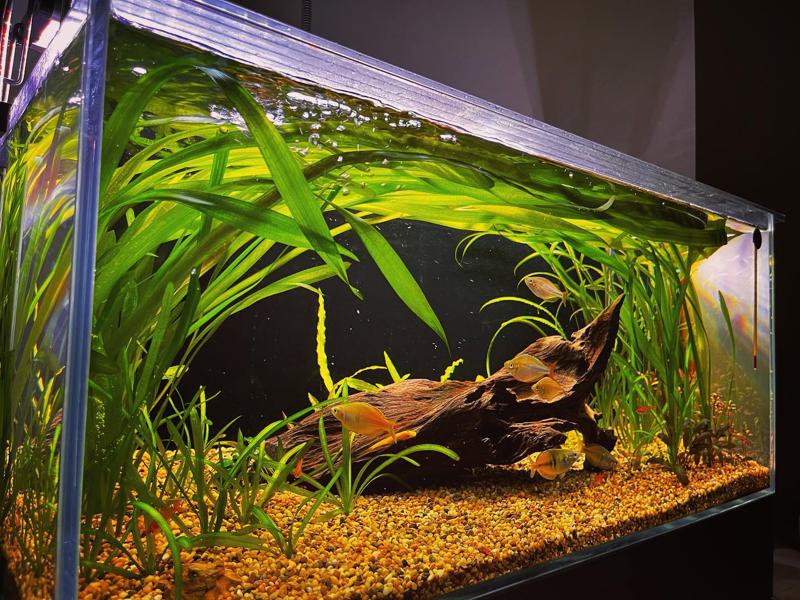
- Scientific name: Vallisneria sp.
- Origin: Asia
- Difficulty of care: Easy
- Level of light: Moderate
Planting Vallisneria creates a grass-themed aesthetic for your betta fish tank.
While the leaves are grassy in growth, they have tiny roots and may only require shallow rooting in the substrate.
You only need a few stalks of Vallisneria at the start. Since they are fast growers, their roots spread fast, producing new grass leaves every few days.
There are two common species of Vallisneria used in a betta fish tank. The Vallisneria spiralis have straight erect leaves, while the Vallisneria gigantea has an enormous growth that bends over the surface.
Using scissors, we highly recommend trimming. Otherwise, the rapid vertical growth of the leaves can impede light penetration.
Pogostemon Stellatus Octopus
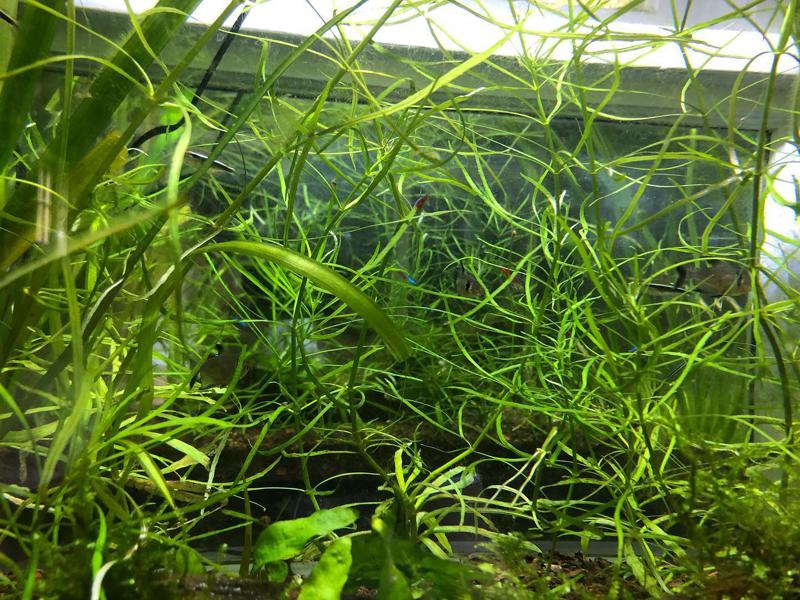
- Scientific name: Pogostemon stellatus
- Origin: Southeast Asia and North Australia
- Difficulty of care: Easy
- Level of light: Moderate
Do not be confused with the word octopus. This plant does not have 8 legs, or should we say 8 stems. Instead, the stems produce long and wavy leaves resembling the legs of an octopus.
We recommend trimming as the plant grows fast but be careful. Betta fish take refuge, especially on the top part of the leaves. Also, you can replant the cuttings since it can grow new roots.
Amazon Frogbit
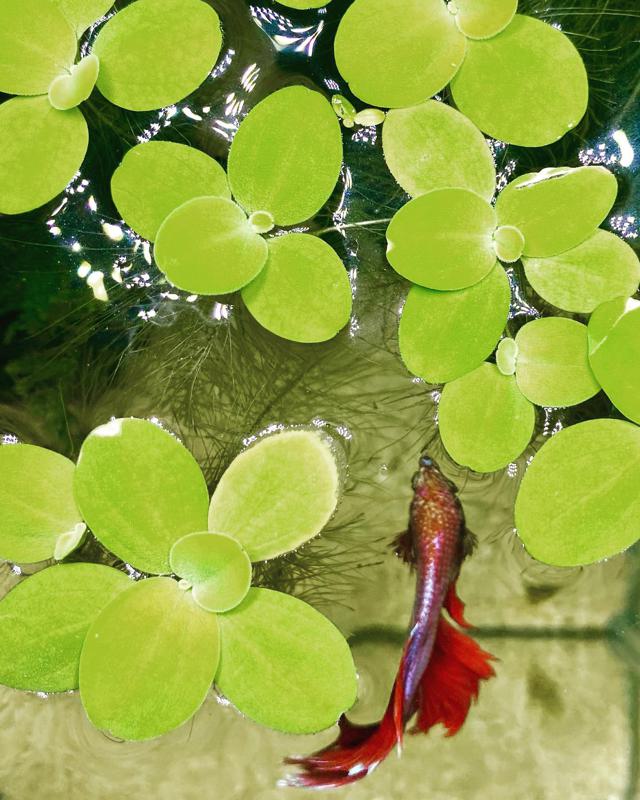
- Scientific name: Limnobium laevigatum
- Origin: Central and South America
- Difficulty of care: Easy
- Level of light: Moderate
The Amazon frogbit is a floating plant with roots suspended in midwater.
Instead of leaves, betta fish loves to swim around the roots of the Amazon frogbit. It grows fast and produces leaves every two days.
We recommend starting with a few plants. With ideal conditions, it grows fast and may cover the entire surface of your tank.
Marimo Moss Balls
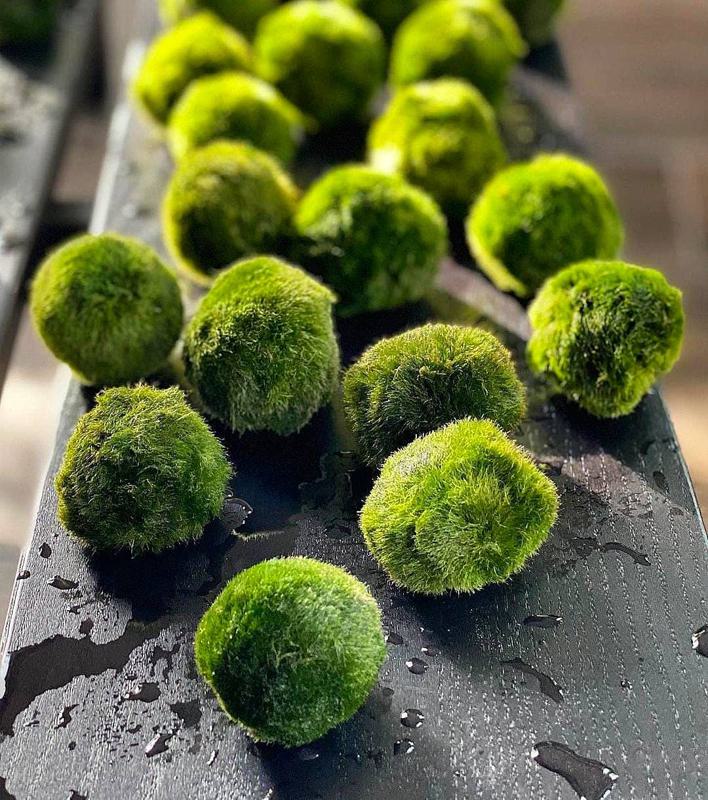
- Scientific name: Aegagropila linnae
- Origin: Japan and Iceland
- Difficulty of care: Moderate
- Level of light: Low
Taxonomically, Marimo moss balls are not moss. They are green algae. But wait, they are not the prolific pests that we don’t want in a tank. The truth is they are one of the few aquatic plants preferred to be stocked in large quantities. The more balls, the more aesthetically pleasing.
Marimo moss balls thrive on the lakes of Japan and Iceland. They are not spherical at first. However, with the constant flow of water, they are naturally rolled to form a ball.
Being coldwater species, Marimo moss balls prefer unheated aquariums. They don’t need any substrate preparation. All you need is to drop them in an area with no direct lighting.
Compared to the 12-inch annual growth in the wild, Marimo moss balls grow as much as 5 mm per year in a tank setting. Betta fish will lay on top of the moss balls. However, with the absence of current in a betta fish tank, expect they will be flattened and deformed over time.
Read More:
- Betta Fish Tank Setup: What to Put In?
- Do Betta Fish Need a Bubbler?
- Best Live Plants for Guppies Tanks
- Best Betta Fish Tank Size
- Best Substrates For Betta Fish
- Easy Plants for Goldfish
FAQs
Are All Plants Safe for Betta Fish?
No. Some plants contain toxins. Betta fish will be poisoned if they nibble on these toxin-containing plants.
Some examples of plants that contain toxins are water hemlock, philodendron, and water lettuce.
Can You Put Live Plants in A Betta Tank?
Yes. Not only do they add beauty, but plants also produce oxygen while absorbing unwanted nutrients in the water.
Further, plants provide shade and betta fish take refuge on their leaves.
Can Betta Fish Live in A Bowl with A Plant?
Yes. But be mindful of having the right plant for a fish bowl. Do not use a large climbing plant that may cover the small surface of a fish bowl.
Conclusion
The main reason why we place plants in a betta fish tank is for their biological and chemical function. Aesthetic improvement should only be the second reason.
Of course, we all love a beautiful betta fish tank. If you wish to have one, do it in a way that represents its actual wild environment. If you mimic it well, you and your betta fish will become happy.